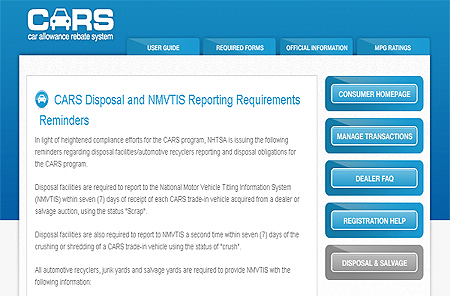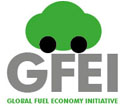
Buy-back
Buy-back programmes have been widely used to accelerate the retirement of older vehicle technology. However, buy-back programmes are usually primarily motivated by economic reasons, with air quality and efficiency considerations secondary. Buy-back programmes go hand-in-hand with the scrappage of older vehicles and require good legislative design in order to avoid the replacement of scrapped cars with larger gas guzzlers.
Buy-backs provide monetary or other incentives to vehicle owners to voluntarily retire their older, often more polluting vehicle. Incentives may be provided directly to the owner, may take the form of tax benefits, or may be paid directly to the newer vehicle vendor.
The balance of costs and benefits from buy-back programmes are not straightforward: while there may be some environmental benefits from voluntary early retirement of obsolete technology, not all pollutants are so closely related to vehicle age. Moreover, fuel economy gains may even lead to an increase of vehicle mileage travelled. In addition, if vehicles are not properly retired (e.g. injection of the engine block with sodium silicate to prevent further recirculation of vehicles or selling to developing countries, as in the US case), then the vehicle could potentially come back into use, through the second hand car trade.
U.S. “Cash for Clunkers” Law
In 2009 the US government signed into law the provision of rebates to prospective car purchasers toward the purchase of new, fuel-efficient vehicles, provided the trade-in vehicles were scrapped. Largely viewed as an effort to assist the sales of the national auto industry, the U.S. Congress and the Administration passed the “cash for clunkers” (also known as the Car Allowance Rebate System - CARS) law. This law gave to buyers of new cars US $3,500 - $4,500 toward the purchase of a new car, with the trade-in of an older, less efficient vehicle that met certain criteria.

Up to $4,500 was transferred to the selling car dealer on the consumer’s behalf if: 1) the traded-in car had been registered and in use for at least a year, and had a federal combined city/highway fuel-economy rating of 18 or fewer miles per gallon; 2) the purchase was of a new car, priced at $45,000 or less and rated at least 4 mpg better than the old one (gets a $3,500 voucher). If the new one gets at least 10 mpg better, the consumer got the full $4,500. Mileage ratings dating back to 1985 are available from www.fueleconomy.gov.
This program cost the U.S. government $3 billion.
The California Air Resources Board also ran a similar program – called the Voluntary Accelerated Vehicle Retirement (VAVR) Program.
France
The scrappage program of France was introduced on January 19, 2009. The old car would need to be older than 10 years and the new car would need to meet a particular CO2 emission standard. The varied incentive system starts with €1000 for a car which emits a maximum of 160 g/km.
Under a bonus-malus system, a premium is granted for the purchase of a new car when its CO2 emissions are below 160 g/km. The maximum premium is €5000 for cars with less than 60 g/km.
This program cost the French government US $554 million.
China
China’s government will extend its buy-back incentive system to the end of 2010 to encourage consumers to buy more fuel-efficient vehicles. The program, enacted in June 2009, was scheduled to end March 31, 2010.
Consumers who trade in light trucks and mini trucks are eligible for a subsidy of 5,000 yuan (US $732) and 4,000 yuan (US $586), respectively.







